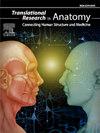提高神经解剖学的教学效果:使用染色和未染色脑切片解读神经解剖横断面的比较研究
Q3 Medicine
引用次数: 0
摘要
背景神经解剖学被认为是解剖学课程中最具挑战性的部分之一,理解神经解剖学的复杂性源于缺乏结构的三维视图。由于一切都呈现灰白色,很难区分大脑横截面上的各种结构,因此染色有助于视觉解读和记忆。有多种染色方法可供选择,如穆利根染色法、阿尔斯通染色法、普鲁士蓝反应法等,但从以往文献中收集的资料来看,阿尔斯通染色法的效果最好。250 名医学专业一年级学生在神经解剖学实践课上展示了染色和未染色的大脑横向切片中的内囊、尾状核、扁桃体和丘脑等特征。结果学生们的反馈很积极,83%的学生更喜欢染色切片而不是未染色切片。结论使用阿尔斯通方法对大脑切片进行显微染色可作为一种有效的神经解剖学教学方法,因为学生能更好地观察染色切片中的结构,从而提高他们对神经解剖学的记忆。由于阿尔斯通染色法产生的收缩最小,这些染色切片可用于研究,此类标本也可进行塑化。本文章由计算机程序翻译,如有差异,请以英文原文为准。
Enhancing the effectiveness of teaching neuroanatomy: A comparative study using stained and unstained brain sections to interpret cross sectional neuroanatomy
Background
Neuroanatomy is considered one of the most challenging parts of anatomy curriculum and the complexity in understanding neuroanatomy generates from the lack of a 3-dimensional view of the structures. Since everything appears grey and white and is difficult to differentiate the various structures in a cross section of brain, staining aids in the visual interpretation and retention. There are various staining methods employed such as Mulligan's method, Alston's method, Prussian blue reaction method, however the results obtained by Alston's method was the best as gathered from previous literature.
Material and methods
The study was conducted in the department of Anatomy, formalin fixed brain slices measuring 10 mm thickness were stained using Alston's method. 250 medical students of the first professional year were demonstrated features such as the internal capsule, caudate nucleus, lentiform and thalamus in the stained and unstained transverse sections of cerebrum during their neuroanatomy practical sessions. Following which a feedback was collected regarding both the specimens using Microsoft Forms.
Results
There was a positive feedback from the students with 83 % of them preferring the stained over the unstained section. Excerpts from the open ended question where all in favour of the stained sections -“much easier to see and identify the parts in the stained section because of the clear distinction between white and grey matter”.
Conclusions
Macroscopic staining of sections of the brain using Alston's method could be implemented as a valuable method for effective teaching of neuroanatomy since students appreciated the structures better in the stained sections which enhanced their retention of neuroanatomy. Since Alston stain produces the least shrinkage, these stained sections could be utilized for research studies and such specimens could also be plastinated.
求助全文
通过发布文献求助,成功后即可免费获取论文全文。
去求助
来源期刊

Translational Research in Anatomy
Medicine-Anatomy
CiteScore
2.90
自引率
0.00%
发文量
71
审稿时长
25 days
期刊介绍:
Translational Research in Anatomy is an international peer-reviewed and open access journal that publishes high-quality original papers. Focusing on translational research, the journal aims to disseminate the knowledge that is gained in the basic science of anatomy and to apply it to the diagnosis and treatment of human pathology in order to improve individual patient well-being. Topics published in Translational Research in Anatomy include anatomy in all of its aspects, especially those that have application to other scientific disciplines including the health sciences: • gross anatomy • neuroanatomy • histology • immunohistochemistry • comparative anatomy • embryology • molecular biology • microscopic anatomy • forensics • imaging/radiology • medical education Priority will be given to studies that clearly articulate their relevance to the broader aspects of anatomy and how they can impact patient care.Strengthening the ties between morphological research and medicine will foster collaboration between anatomists and physicians. Therefore, Translational Research in Anatomy will serve as a platform for communication and understanding between the disciplines of anatomy and medicine and will aid in the dissemination of anatomical research. The journal accepts the following article types: 1. Review articles 2. Original research papers 3. New state-of-the-art methods of research in the field of anatomy including imaging, dissection methods, medical devices and quantitation 4. Education papers (teaching technologies/methods in medical education in anatomy) 5. Commentaries 6. Letters to the Editor 7. Selected conference papers 8. Case Reports
 求助内容:
求助内容: 应助结果提醒方式:
应助结果提醒方式:


